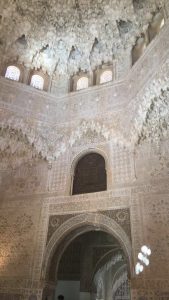By: Tiye Flavien
Introduction
Light has continuously shown its importance in architecture and said importance is evident in the architectural structures of Andalusia. For Islamic, Jewish, and Christian communities alike, light was an essential element to bring the divine spirit of God to worshipers. Light in architectural domains was used to symbolize both philosophical and theological ideology which were two significant areas of study during this time. The connection between light and people were accessible to all individuals bridging class and cultural divides. My time spent in the architectural buildings of al-Andalus intrigued my interest in the dependence on light in these spaces.

Light in Religious Spaces
The use of light in churches, synagogues, and mosques was (and still today) to connect the divine world with the humanistic realm. Light in a sense was a representation of unity between God and his people. In mosques, light often reflected off the painted tiles and colored glass. This evoked a perception of spirituality and divinity. Christian churches utilized stain glass windows to highlight biblical scenes for visual interpretation. Natural light guided through open arches or large windows gave the religious community the sense of perfection and beauty associated with the divine world. The use of light greatly enhanced the religious experience for those in attendance.

Placement of Light
The most apparent placement of light is from far above. Windows and arches would open to the sky allowing light to penetrate from above. Ceilings too were a great location for openings. This gave worshipers the opportunity to bridge the space of Earth and Heaven through the sky. The radiance of light from above would wash over visitors, engulfing them in what could be perceived as the spirit of God. Light in conjunction with the dome structures of mosques led to an accentuation of space. These already large buildings were made to appear empty and effortless. The interesting part of the placement of light is that us was not only restricted to places of worship.

Use of Light in Other Spaces
An interesting aspect of light in Iberian architecture is that is was not only found as an element in religious spaces. Upon the tour of the region, a notable place I observed light was in bathing houses. This demonstrated the high importance of religion in the everyday lives of Andalusians. In the ceilings of bath houses, geometric openings would allow light to enter from the ceiling. Bathing with light pouring in from above was an act of self-purification. The ability to wash away past deeds in the presence, and possibly interpreted forgiveness, of God.

Takeaway
Light in the architecture of Andalusia was a symbolic art form that resonated with individuals from all walks of life. Light was interpreted to represent divinity, spirituality, and intellect. From the perspective of an outsider of the period, the genius of the architecture is incomprehensible. To create such work without the advancements of today is admirable and has shown me why al-Andalus was a pinnacle of medieval Spain.
